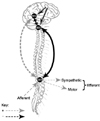Abstract
Patients following traumatic brain injury (TBI) sometimes display paroxysmal autonomic and muscle overactivity, which is suspicious to self-limiting or permanent disability. There are still no standard definition and diagnostic tools for autonomic dysfunction after TBI. Dysautonomia has been used as the most dominant term by authors of papers, was defined as simultaneous paroxysmal increases in at least five out of the seven features (heart rate, respiratory rate, blood pressure, temperature, posturing, dystonia and sweating) with episodes persisting for at least 2 weeks after injury. Heart rate variability (HRV) may be helpful to diagnosis the dysautonomia. The available evidence for managing of dysautonomia was intravenous morphine, Gabapentin, Bromocriptine and intrathecal baclofen infusion. Therefore, future efforts should be targeted at multicenter, large sample studies to make the diagnostic criteria and to evaluate the incidence, natural history and management of autonomic dysfunction after TBI.
Figures and Tables
References
1. Penfield W. Diencephalic autonomic epilepsy. Arch Neurol Psychiatry. 1929. 22:358–374.
2. Perkes I, Baguley IJ, Nott MT, Menon DK. A review of paroxysmal sympathetic hyperactivity after acquired brain injury. Ann Neurol. 2010. 68:126–135.
3. Baguley IJ, Nicholls JL, Felmingham KL, Crooks J, Gurka JA, Wade LD. Dysautonomia after traumatic brain injury: a forgotten syndrome? J Neurol Neurosurg Psychiatry. 1999. 67:39–43.
4. Baguley IJ, Slewa-Younan S, Heriseanu RE, Nott MT, Mudaliar Y, Nayyar V. The incidence of dysautonomia and its relationship with autonomic arousal following traumatic brain injury. Brain Inj. 2007. 21:1175–1181.
5. Blackman JA, Patrick PD, Buck ML, Rust RS Jr. Paroxysmal autonomic instability with dystonia after brain injury. Arch Neurol. 2004. 61:321–328.
6. Keren O, Yupatov S, Radai MM, Elad-Yarum R, Faraggi D, Abboud S, Ring H, Groswasser Z. Heart rate variability (HRV) of patients with traumatic brain injury (TBI) during the post-insult sub-acute period. Brain Inj. 2005. 19:605–611.
7. Baguley IJ, Heriseanu RE, Felmingham KL, Cameron ID. Dysautonomia and heart rate variability following severe traumatic brain injury. Brain Inj. 2006. 20:437–444.
8. Baguley IJ, Nott MT, Slewa-Younan S, Heriseanu RE, Perkes I. Diagnosing dysautonomia after acute traumatic brain injury: evidence for overresponsiveness to afferent stimuli. Arch Phys Med Rehabil. 2009. 90:580–586.
9. Katz-Leurer M, Rotem H, Keren O, Meyer S. Heart rate and heart rate variability at rest and during exercise in boys who suffered a severe traumatic brain injury and typically-developed controls. Brain Inj. 2010. 24:110–114.
10. Baguley IJ, Heriseanu RE, Cameron ID, Nott MT, Slewa-Younan S. A critical review of the pathophysiology of dysautonomia following traumatic brain injury. Neurocrit Care. 2008. 8:293–300.
11. Baguley IJ. The excitatory: inhibitory ratio model (EIR model): an integrative explanation of acute autonomic overactivity syndrome. Med Hypotheses. 2008. 70:26–35.
12. Bullard DE. Diencephalic seizure: responsiveness to bromocriptine and morphin. Ann Neurol. 1987. 21:609–611.




 PDF
PDF ePub
ePub Citation
Citation Print
Print




 XML Download
XML Download